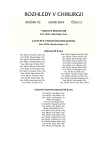The use of telemetric intracranial pressure monitoring in the differential diagnosis of idiopathic intracranial hypertension – a case report
Authors:
V. Vybíhal 1; A. Mrlian 1; E. Neuman 1; R. Uhmannová 2; A. Šprláková-Puková 3; M. Smrčka 1
Authors‘ workplace:
Neurochirurgická klinika, LF MU a FN Brno, přednosta: Prof. MUDr. M. Smrčka, Ph. D., MBA
1; Oční klinika, LF MU a FN Brno, přednosta: Prof. MUDr. E. Vlková, CSc.
2; Radiologická klinika, LF MU a FN Brno, přednosta: Prof. MUDr. V. Válek, CSc., MBA
3
Published in:
Rozhl. Chir., 2014, roč. 93, č. 2, s. 82-86.
Category:
Case Report
Podpořeno projektem (Ministerstva zdravotnictví) koncepčního rozvoje výzkumné organizace 65269705 (FN Brno).
Overview
Idiopathic intracranial hypertension is a disorder that results from an increase of intracranial pressure with unknown cause. A single measurement of intracranial pressure only provides data at one given point in time. Therefore, telemetric monitoring of intracranial pressure was performed in a patient with fluctuating headache and significantly impaired vision, which together accounted for 226.2 hours of recording during normal daily activities. Elevated intracranial pressure was not found during monitoring, so we did not indicate the patient for shunt surgery.
Key words:
idiopathic intracranial hypertension – telemetry – intracranial pressure
Sources
1. Bekar A, Dogan S, Abas F, et al. Risk factors and complications of intracranial pressure monitoring with a fiberoptic device. J Clin Neurosci 2009;16:236–240.
2. Raboel PH, Bartek J Jr., Andersen M, et al. Intracranial pressure monitoring: invasive versus non-invasive methods – a review. Critical Care Research and Practice 2012: Article ID 950393.
3. Bratton SL, Chesnut RM, Ghajar J, et al. Guidelines for the management of severe traumatic brain injury. VI. Indications for intracranial pressure monitoring. Journal of Neurotrauma 2007;24(Suppl. 1):S37–S44.
4. Forsyth RJ, Wolny S, Rodrigues B. Routine intracranial pressure monitoring in acute coma. Cochrane Database of Systematic Reviews 2009;3:Article ID CD002043.
5. Lenfeldt N, Koskinen LOD, Bergenheim AT, et al. CSF pressure assessed by lumbar puncture agrees with intracranial pressure. Neurology 2007;68(2):155–158.
6. Bratton SL, Chesnut RM, Ghajar J, et al. Guidelines for the management of severe traumatic brain injury. VII. Intracranial pressure monitoring technology. Journal of Neurotrauma 2007;24 (Suppl. 1):S45–S54.
7. Lang JM, Beck J, Zimmermann M, et al. Clinical evaluation of intraparenchymal Spiegelberg pressure sensor. Neurosurgery 2003;52:1455–1459.
8. Gelabert-Gonzalez M, Ginesta-Galan V, Sernamito-Garcia V, et al. The Camino intracranial pressure device in clinical practice. Assessment in a 1000 cases. Acta Neurochirurgica 2006;148: 435–441.
9. Citero G, Piper I, Chambers IR, et al. Multicenter clinical assessment of the raumedic Neurovent-P intracranial pressure sensor: a report by the brainIT group. Neurosurgery 2008;63:1152–1158.
10. Leskot T, Reina V, le Manach Y, et al. In vivo accuracy of two intraparenchymal intracranial pressure monitors. Intensive Care Medicine 2011;37:875–879.
11. Hong WC, Tu YK, Chen YS, et al. Subdural intracranial pressure monitoring in severe head injury: clinical experience with the Codman MicroSensor. Surgical Neurology 2006;66(Suppl. 2): S8–S13.
12. Koskinen LOD, Olivecrona M. Clinical experience with the intraparenchymal intracranial pressure monitoring Codman microsensor system. Neurosurgery 2005;56:693–698.
13. Welschehold S, Schmalhausen E, Dodier P, et al. Neurosurgery 2012;70(Suppl. 1):44–49.
14. Shellock FG. Biomedical implants and devices: assessment of magnetic field interactions with a 3.0-Tesla MR system. Journal of Magnetic Resonance Imaging 2002; 16:721–732.
15. Stendel R, Heidenreich J, Schilling A, et al. Clinical evaluation of a new intracranial pressure monitoring device. Acta Neurochirurgica 2003;145:185–193.
16. Fadrus P, Smrčka V, Smrčka M, et al. Monitorování intraparenchymového a intrahematomového tlaku při stereotaktické evakuaci spontánních intracerebrálních hematomů. Cesk Slov N Neurol 2005;68:303–309.
17. Frim DM, Goumnerova LC. Telemetric intraventricular pressure measurements after third ventriculocisternostomy in a patient with noncommunicating hydrocephalus. Neurosurgery 1997;41: 1425–1428.
18. Chapman PH, Cosman E, Arnold M. Telemetric ICP monitoring after surgery for posterior fossa and third ventricular tumors. Technical note. J Neurosurg 1984;60:649–651.
19. Richard KE, Block FR, Weiser RR. First clinical results with a telemetric shunt-integrated ICP-sensor. Neurol Res 1999;21: 117–120.
Labels
Surgery Orthopaedics Trauma surgeryArticle was published in
Perspectives in Surgery

2014 Issue 2
Most read in this issue
- Evaluation of safe resection margins in tumours of parenchymatous organs
- Evaluation of safe resection margins in rectal carcinoma
- Evaluation of safe margins in pathology examination in breast oncosurgery
- Clostridium colitis at a surgical department
